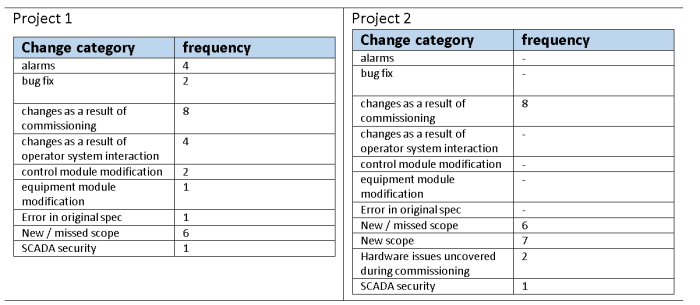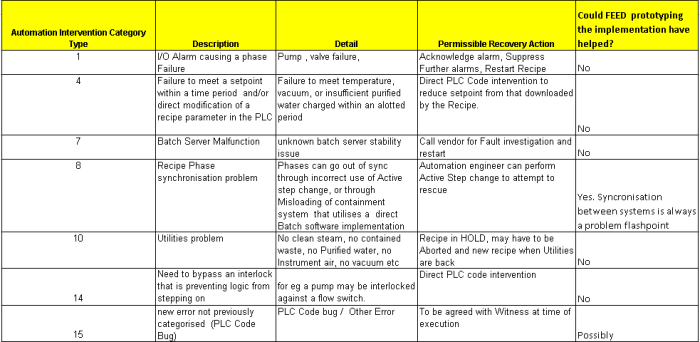A IHS study noted that the average programming budget costs for changes after design specification for process automation projects was 23%. With this in mind, we looked at 3 punchlists that were compiled during the commissioning phase of 3 separate process automation projects. The automation systems examined were combination PLC / SCADA systems; different vendor skids on the network had their own PLC controllers but there was a unified SCADA system utilised for the separate PLCs. In addition, for project 1 & 2 there was no ISA-S88 Batch integration; there was no need to tightly synchronise a phase on one piece of equipment with a phase on another piece of equipment. (Project 3 has ISA-S88 Batch integration and did have a tight synchronisation requirement)
We attempted to classify typical process automation software issues highlighted during commissioning and ongoing operations and this is what resulted:
It is not a surprise to see that there are plenty of software changes as a result of commissioning (setpoint changes, alarm changes, recipe parameter changes etc). The second biggest culprit for software changes during commissioning is new or missed scope. A significant amount of these changes resulted from interfaces to 3rd party systems. The use of a control system modelling tool to capture requirements can reduce the amount of new scope introduced during commissioning and changes are cheaper to implement earlier in a project.
Commissioning equipment where tightly coupled ISA-S88 Batch integration is implemented
Manufacturers are trying to consolidate their equipment vendors batch control systems as this reduces operational cost. But this is not easy and it is only getting harder as the process industry migrates towards module based production. Namur working group NE148 is trying to figure out the best way to integrate all these process modules possibly into an existing supervisory batch control system. Process equipment vendors are not necessarily batch software experts. The following real life example illustrates the challenges.
In project 3, there is a need to tightly synchronise a phase on one piece of equipment with a phase running on another piece of equipment. One of the most difficult to commission batch scenarios is when 2 control systems from different vendors are tightly coupled in a batch implementation. This brings substantial commissioning problems as evidenced below. The following table lists the most common automation interventions during one week of water testing the batch control recipes. Different vendors supplied the different equipment vendor PLC phase programming.
One way to improve reliability of this complex batch implementation is to provide an emulation of the target system behaviour to each equipment vendor (another way, is to make sure the same SI programs everything on the same Batch DCS, but equipment vendors may not agree to this). Diagnosing inter system synchronisation issues on live plant is the nightmare scenario to be avoided at all costs.
Lack of education on the batch system was not listed, but affected the amount of time it took to diagnose a problem. System education and the wireframing out of inter system synchronisation were the main areas that could have been helped through the use of prototyping.
Conclusion
Modelling can reduce the amount of missed scope manifesting at commissioning time, can help improve the testing of inter system dependencies and can help improve everyone’s understanding of the batch automation process.
See Spike in action or try it yourself, no sign up or login required.


